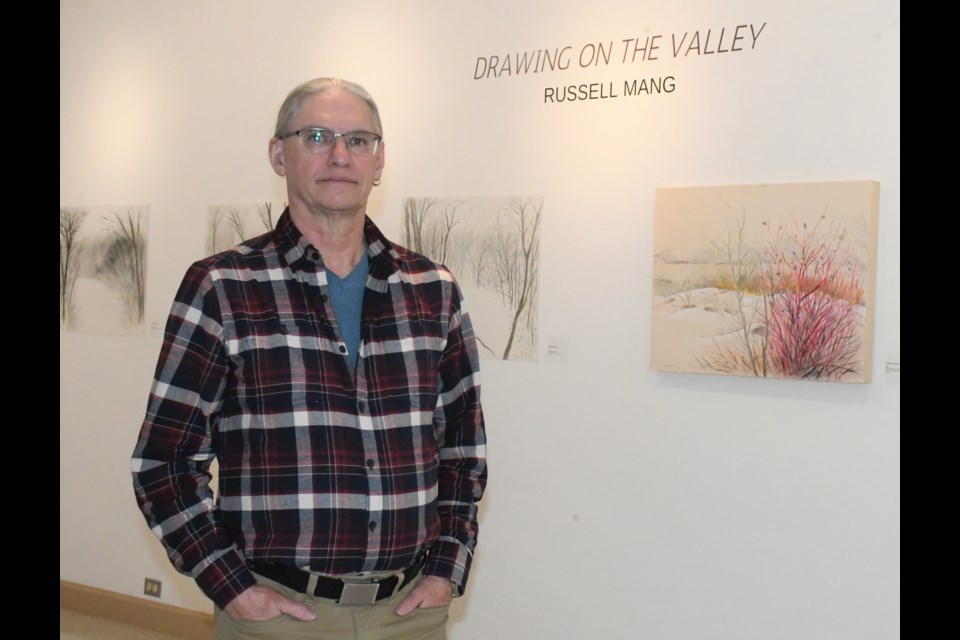Of the drawings that artist Russell Mang has created for a new exhibit, perhaps the most noticeable is a scene from Wakamow Valley of a bright, red-coloured dogwood plant against a white winter background.
The Moose Jaw Culture Centre is hosting Mang’s “Drawing on the Valley” exhibit from now until March 25. The display features 20 scenes that he painted between 2019 and 2022, with the artist having drawn five on location — including “Dogwood and Ice Fog” — and the rest in his studio.
This show marks 10 years since his last display in February-March 2013.
The exhibition's title is a play on two themes: nature — Wakamow Valley in particular — as an inspirational source and the process of drawing as its own art form.
Mang’s focus after graduating from university in 1982 was on painting landscapes “plein air” — on site — using watercolours, which he continued for decades, he explained to the Express. However, his approach has evolved to attempting to develop a “vocabulary” to describe what he feels inside.
He regards the contemplative life as his vocation, while he expresses the practice of being attentive to “the presence” — God or the universe — through his artmaking.
Mang and his wife moved to Moose Jaw in September 2007, but it wasn’t until 2010 that he “discovered” Wakamow Valley, which began to inspire his work.
“I’ve really come to love it very much and try to get down there as often as I can,” Mang said.
From 2009 to 2015, Mang focused most of his work on the surrounding prairies because they most spoke to him. However, he later found himself attracted to the valley’s interior spaces, including its walking trails and — more specifically — Paashkwow Park.
In the last decade, his inner vocabulary has moved from the expansiveness of the prairies to a more “interior” space found in the bushes and trail spots.
Mang draws or paints his pieces on site often, although he does take photographs of scenes and then re-creates those images in his studio.
“Though I work from the landscape, all of my work is driven by my intuition and subconscious,” he said.
Another subject of Mang’s artworks is prairie grasses, which he sees as metaphorical and symbolic. He noted that many people respond well to those artworks, although he doesn’t know why. Yet, creating grass pieces gives him another way to express his inner vocabulary, including about life, death, mortality and resilience.
“It is my hope that people will look at the landscape pieces and grasses and see them on more than one level,” he stated.
The art world never took seriously artists who drew their work, but that attitude is changing, said Mang. Most people don’t take drawings seriously, either, since they see them as small-scale and preparatory for larger works.
People also have a mental hierarchy of what’s important, such as watercolour or oil and acrylic, instead of drawings.
“As a visual artist and someone who has worked in all those mediums, they are all equal in my mind,” said Mang.
The irony of the situation is he still refers to his drawings as paintings even though he consciously attempts to call them works or pieces.
While Mang worked mainly with watercolours and oil and acrylics in his career, he has worked more with dry media such as graphite and pastel sticks during the past decade.
However, this has presented a challenge since he must protect the surfaces from damage. Yet, he doesn’t like using glass because of the cost and the fact it puts a wall between the work and the viewer. So, he has attempted to make his works more robust so they can be handled without smudging them.
“… but that’s also congruent with my approach to life, to accept vulnerability as an ongoing aspect of life. You can’t always protect yourself,” said Mang.
What Mang appreciates about the gallery is the interior walls can be moved around. For his display, he removed them entirely so the space could be wide open, similar to the valley’s vast spaces.




